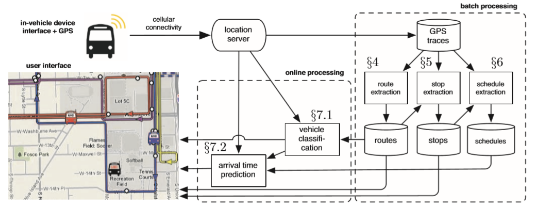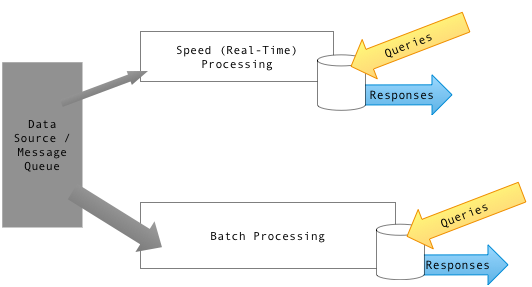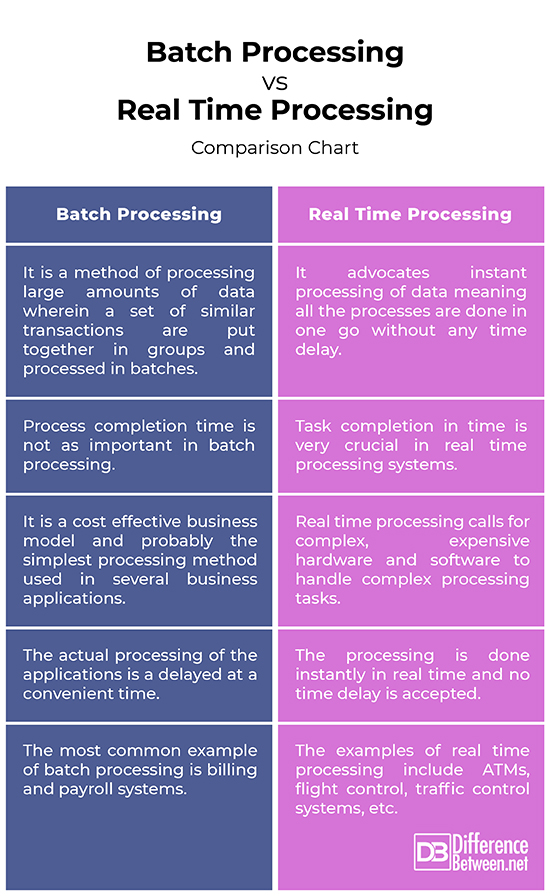Difference Between Batch Processing and Real Time Processing
There are two common types of data processing systems that are used across several industries and organizations for efficiently managing their operations – batch processing and real time processing. In this article, we tell you about each processing technique in detail and also help you learn some key differences between the two.

What is Batch Processing?
Batch processing, as the name suggests, is a method of processing large amounts of data wherein a set of similar transactions are grouped together for a specific period of time. This is ideally suited for processing insane volumes of data where the data is collected automatically. Batch processing is widely used in manufacturing industries where manufacturing operations are implemented at a large scale. For example, batch processing is an important segment of the chemical process industries. A growing number of the world’s chemical production by both volume and value is made in batch plants. Batch processing is characterized by its greater degree of flexibility in operations and rapid response to evolving market conditions. A simple example of batch processing is when you’re doing your own washing you’ll most likely to wait until you had a reasonable quantity to put in the washer all in a single go. You would collect for about a week and wash them in batches.

What is Real Time Processing?
Sometimes you’d not want to wait or delay the work for a more convenient time and you’d rather do it instantly, let’s say in real time. Suppose you do not want to wait until the end of the week to do the washing; you’ll do so as soon as an item is dirty. This is an example of real time processing. So, unlike batch processing, real time processing can be categorized as real time meaning all the processes are done in one go without any time delay. One of the best examples of real time processing is computer control wherein a computer responds instantly to occurring events such as flight control, ATM machines, traffic control systems, mobile devices, etc. In the computing terms, real time processing refers to streams of data that are collected and processed in real time without time delay. As soon as the data comes, it goes to processing, so continuous flow of input data is required to provide instant output.
Difference between Batch Processing and Real Time Processing
Basics
– Batch processing, as the name suggests, is a method of processing large amounts of data wherein a set of similar transactions are grouped together for a specific period of time. Jobs with similar requirements are usually put in batches and then processed together as a group. On the contrary, real time processing advocates instant processing of data meaning all the processes are done in one go without any time delay. As soon as the data comes, it goes to processing.
System
– Batch processing is an efficient and effective method of processing huge volumes of data where the system is able to handle frequent, repetitive jobs such as accounting processes in batches. It is ideally suited to high volume processing wherein the data is collected automatically. Batch processing systems are characterized by their greater degree of flexibility in operations and rapid response to evolving market conditions. Real time processing, on the contrary, happens immediately; as soon as a transaction takes place, it is processed. The systems need to be very active and responsive at all times.
Efficiency
– Batch processing is best suited to systems that require handling large amounts of similar transactions and then processing at regular intervals of time. It is a cost effective business model and probably the simplest processing method used in several business applications. It allows organizations to process tasks when computing or other resources are readily available. Real time processing, on the other hand, is characterized by the continuous flow of input data with minimal latency requirements for processing. Real time processing calls for complex, expensive hardware and software to handle complex processing tasks.
Example
– One of the common examples of batch processing systems is billing and payroll systems where the processes are mostly done at the end of each month in cycles. No end user interaction is required and multiple transactions are processed in groups which can save a great deal of money and time. The examples of real time processing systems include ATMs, flight control, traffic control systems, etc. Real time processing systems respond immediately to actions, for example, in a flight control system, the flight’s on-board computers respond instantly to changing conditions such as air pressure, wind speed, and so on.
Batch Processing vs. Real Time Processing: Comparison Chart

Summary
The choice of whether to use batch processing or real time processing depends on many factors, such as cost effectiveness, scale of operations, computer usage, and so on. Batch processing is ideally suited for high volume processing applications where the data is collected automatically and processed in batches such as payroll and billing systems. Real time processing, as the name suggests, happens instantly meaning as soon as a transaction takes places, it is processed with no time delay. Everything that is computer controlled is an example of real time processing. However, unlike batch processing, real time processing systems would require continuous flow of input data to provide constant output.
- Difference Between Caucus and Primary - June 18, 2024
- Difference Between PPO and POS - May 30, 2024
- Difference Between RFID and NFC - May 28, 2024
Search DifferenceBetween.net :
Leave a Response
References :
[0]Barker, Mike and Jawahar Rawtani. Practical Batch Process Management. Amsterdam, Netherlands: Elsevier, 2004. Print
[1]Heathcote, Pat M. ‘A’ Level ICT. London, United Kingdom: Payne-Gallway Publishers, 2003. Print
[2]Doyle, Stephen and Bob Penrose. Information Systems for You. Cheltenham, United Kingdom: Nelson Thornes, 2001. Print
[3]Image credit: https://commons.wikimedia.org/wiki/File:Diagram_of_Lambda_Architecture_(generic).png
[4]Image credit: https://commons.wikimedia.org/wiki/File:Batch_Processing.png
